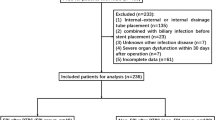Abstract
Purpose
To develop a model to predict successful bilirubin decrease following percutaneous biliary drain placement.
Methods
A total of 257 patients who were identified having undergone percutaneous transhepatic biliary drain placement (PTBD) at our institution between 2002 and 2013 had their medical records and imaging reviewed. Of those, 190 of these patients met criteria and were used in the analysis. A regression model was performed on logarithm-transformed collected variables to predict post-drainage logarithmic transformed total bilirubin levels. A stepwise variable selection method based on Schwarz Bayesian Information Criterion was used to select the most closely associated variables. The model was validated with a Monte Carlo simulation. A short program was developed to calculate the point estimate using the model developed and compared to actual values.
Results
The variables that best predicted bilirubin reduction were initial Tbl (PrTbl), INR and ALT. The selected model had a root mean squared error of 0.8. The model had a negative predictive value (PoTbl is below 2 mg/dL) of 83%.
Conclusions
PTBD may not achieve decreasing bilirubin in patients with a malignant obstruction. This is an initial model that can help determine which patients may not benefit from PTBD placement. With more patients, the model’s validity can be increased and provide useful clinical determinant to aide patient care.




Similar content being viewed by others
References
Ballinger AB, McHugh M, Catnach SM, Alstead EM, Clark ML. Symptom relief and quality of life after stenting for malignant bile duct obstruction. Gut. 1994;35(4):467–70.
Covey AM, Brown KT. Palliative percutaneous drainage in malignant biliary obstruction. J Support Oncol. 2006;4:269–73.
Delden O, Laméris J. Percutaneous drainage and stenting for palliation of malignant bile duct obstruction. Eur Radiol. 2008;18(3):448–56.
Donelli MG, Zucchetti M, Munzone E, D’Incalci M, Crosignani A. Pharmacokinetics of anticancer agents in patients with impaired liver function. Eur J Cancer. 1998;34(1):33–46.
Dong II G, Gi-Young K, Kyu-Bo S, et al. Clinical outcomes after percutaneous biliary interventions in patients with malignant biliary obstruction caused by metastatic gastric cancer. Acta Radiol. 2012;53(4):422–9.
Eklund JW, Trifilio S, Mulcahy MF. Chemotherapy dosing in the setting of liver dysfunction. Oncology. 2005;19(8):1057–63 (discussion 1063-1054, 1069).
Green RM, Flamm S. AGA technical review on the evaluation of liver chemistry tests. Gastroenterology. 2002;123(4):1367–84. doi:10.1053/gast.2002.36061.
Kennedy TJ, Yopp A, Qin Y, et al. Role of preoperative biliary drainage of liver remnant prior to extended liver resection for hilar cholangiocarcinoma. HPB. 2009;11(5):445–51.
Levy JL, Sudheendra D, Dagli M, et al. Percutaneous biliary drainage effectively lowers serum bilirubin to permit chemotherapy treatment. Abdom Radiol. 2016;41(2):317–23.
Mahgerefteh S, Hubert A, Klimov A, Bloom AI. Clinical impact of percutaneous transhepatic insertion of metal biliary endoprostheses for palliation of jaundice and facilitation of chemotherapy. Am J Clin Oncol. 2015;38(5):489–94.
Najafabadi MM, Villanustre F, Khoshgoftaar TM, Seliya N, Wald R, Muharemagic E. Deep learning applications and challenges in big data analytics. J Big Data. 2015;2(1):1–21.
Robson PC, Heffernan N, Gonen M, et al. Prospective study of outcomes after percutaneous biliary drainage for malignant biliary obstruction. Ann Surg Oncol. 2010;17(9):2303–11.
Thornton RH, Ulrich R, Hsu M, et al. Outcomes of patients undergoing percutaneous biliary drainage to reduce bilirubin for administration of chemotherapy. J Vasc Interv Radiol. 2012;23(1):89–95.
Tsai H, Chiao-Hsiung C, Xi-Zhang L. Factors relating to the short term effectiveness of percutaneous biliary drainage for hilar cholangiocarcinoma. World J Gastroenterol. 2009;15(41):5206–10.
Venook AP, Egorin MJ, Rosner GL, et al. phase i and pharmacokinetic trial of gemcitabine in patients with hepatic or renal dysfunction: Cancer and Leukemia Group B 9565. J Clin Oncol. 2000;18(14):2780–7.
Weston BR, Ross WA, Wolff RA, et al. Rate of bilirubin regression after stenting in malignant biliary obstruction for the initiation of chemotherapy. Cancer. 2008;112(11):2417–23.
Author information
Authors and Affiliations
Corresponding author
Ethics declarations
Conflict of interest
On behalf of all authors, the corresponding author states that there is no conflict of interest.
Ethical Approval
For this type of study, formal consent is not required.
Electronic Supplementary Material
Below is the link to the electronic supplementary material.
Rights and permissions
About this article
Cite this article
Khosla, A., Xi, Y. & Toomay, S. Predicting Success in Percutaneous Transhepatic Biliary Drainage. Cardiovasc Intervent Radiol 40, 1586–1592 (2017). https://doi.org/10.1007/s00270-017-1679-0
Received:
Accepted:
Published:
Issue Date:
DOI: https://doi.org/10.1007/s00270-017-1679-0




